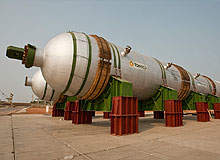
Russian oil and gas company Tatneft is building an oil refinery and petrochemical complex in Nizhnekamsk in the Republic of Tatarstan, Russia. Tatneft proposed the project in 2005 and established a subsidiary, Taneco, in 2006 to execute the project.
Tatneft invested $5.8bn in the first phase of the project. The Russian Investment Fund also provided $571m to construct the external infrastructure including a product line and a railway line.
The three-phase project consists of a refinery with a processing capacity of seven million tonnes per year of sulphur crude, a deep conversion refining plant with an output of 3.5 million tonnes per year, and a petrochemical complex to produce polypropylene, polyethylene and other products. The first phase was completed with start up in October 2010.
The refinery is used to process high-sulphur crude into high-value products. Tatneft owns about 900 million tonnes of oil reserves.
By constructing the refinery, the company plans to sell value-added petroleum products and protect itself from market fluctuations.
Construction and infrastructure
The Taneco refinery will be spread over 311.5ha. The first phase included the refinery, a CDU / VDU-7 unit, sulphur recovery units, an aromatics unit, kerosene hydro-treating units, a sludge visbreaker and a naphtha stabilising unit.
The deep conversion complex units will be built in the second phase. These include the delayed coker, a catalytic cracker, heavy coking gas hydrotreaters, a base oil production unit and a sulphur alkyllation unit.
Several other units will be built in the third phase. These will include an 80,000t per year linear alkylbenzene unit, a 200,000t per year polypropylene unit, a purified terephtalic acid unit and a 250,000t per year polyethylene terephthalate unit.
Contractors for the Taneco refinery
Tatneft contracted Fluor in September 2007 to provide project management services for the Taneco refinery project. Fluor also provided select engineering, procurement and construction management services for the utilities and the complex’s infrastructure.
Foster Wheeler carried out the front-end engineering design of the project. VNIPIneft, a Russian engineering institute, designed the complex. Tekfen Construction and Installation conducted the preliminary engineering works. The general contractor of the pipeline was Glavneftegazstroyservis Construction Company.
Tatneft signed licence agreements with several companies to supply technology for various units of the complex. Some of the companies include STRATCO-DuPont, Haldor Topsoe, UOP, Shell Global Solutions International and Axens. Foster Wheeler provided delayed coking process technology.
La Seda de Barcelona supplied technology for the complex’s PTA and PET plants and UOP provided the technology for an 80,000t per year LAB unit.
LyondellBasell provided its Spherizone technology, which involves a multi-zone circulating reactor process to produce polypropylene. CLG’s Isodewaxing / Isofinishing technologies are used to produce lubricant base oils.
Yokogawa Electric Corporation’s subsidiary, Yokogawa Electric CIS, was appointed the main automation contractor for the project. Yokogawa supplied control systems for various units of the complex as part of the contract.
Pipeline route
In May 2009, Tatneft signed a $385m contract with pipeline operator Transneft for the construction of a 118.2km oil pipeline to supply high-sulphur oil from Tatarstan to the Nizhnekamsk refinery. The pipeline connects the refinery to the Kaleykino oil pumping station in the Almetyevsk region of Tatarstan.
The contract also included the construction of a 183km product pipeline to transport 2.4 million tonnes per year of diesel fuel from the refinery through Almetyevsk to Kstovo. These two pipelines were completed at the end of 2009.

